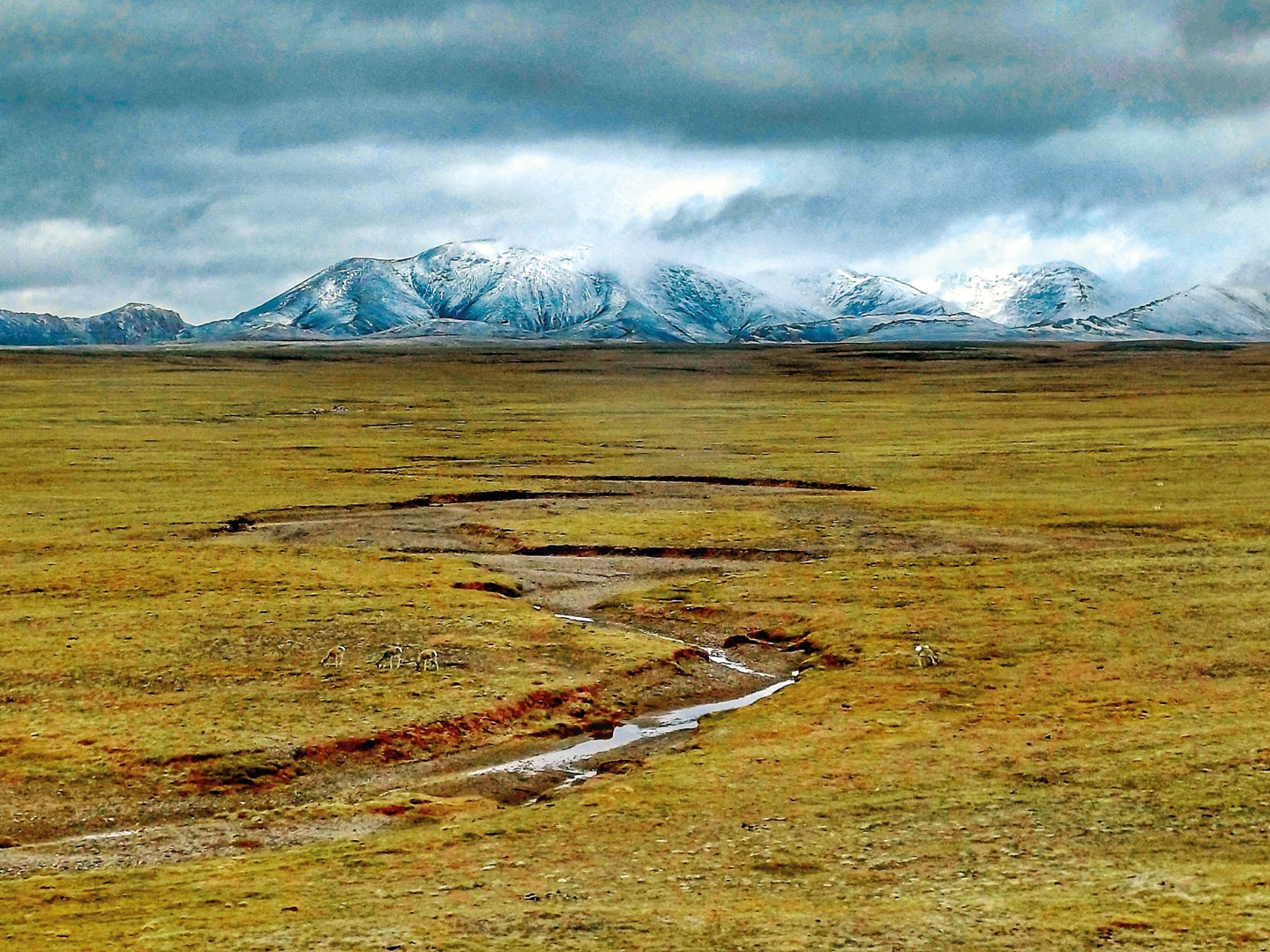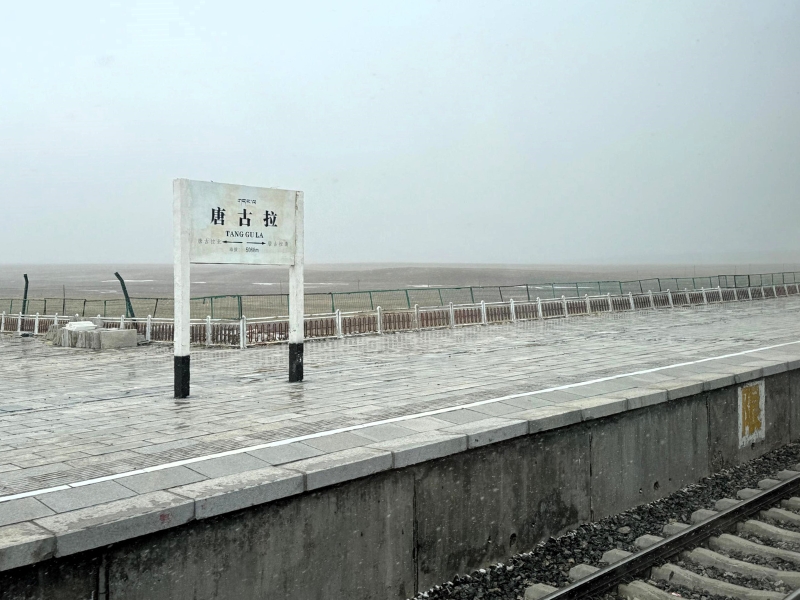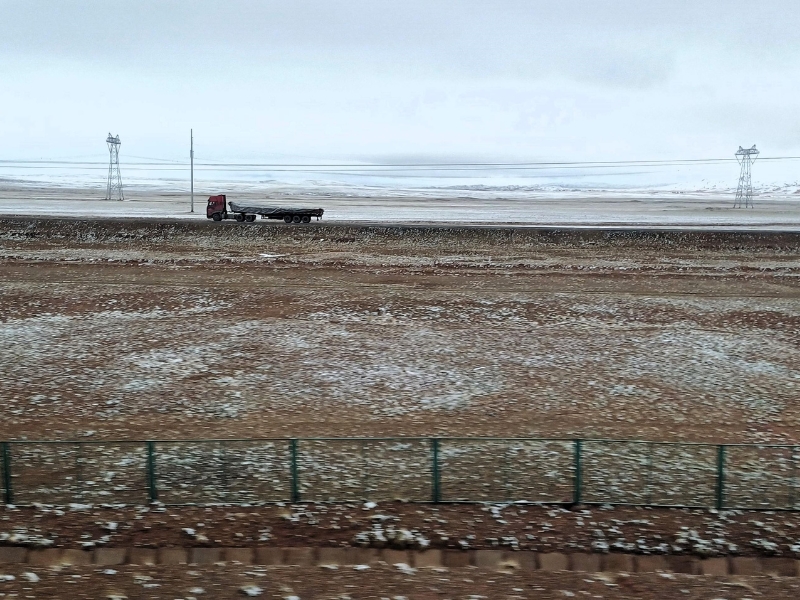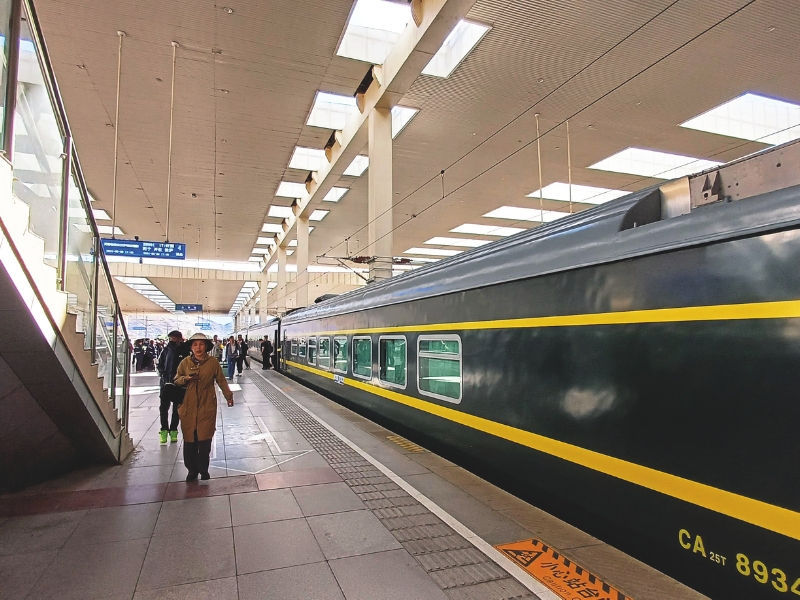
There are several large nature reserves on the highland plateau that the railway runs across. Spot antelope grazing beside the river with snowy mountains in the background. (All photos: Lee Yu Kit)
It had just turned light when I woke up. Outside the large glass window was a landscape from a sci-fi movie: the ground was flat, smooth, dark grey and streaked with white. On the horizon were rounded hills stippled and covered in snow beneath a featureless ashen sky. I was on the world’s highest and largest plateau, the Qinghai-Tibet plateau, and I was in a train.
This wasn’t just any train on any railroad. This was the Xining-Lhasa railroad, which was widely regarded as being impossible to build. A project of such scale at such an altitude had never been attempted.
The project’s feasibility was challenged by low oxygen levels at high altitudes, the absence of supporting infrastructure and logistics, the need to construct long sections on unstable permafrost, the environmental impact on a fragile highland ecosystem, and the complex engineering required to build a railroad and operate a train in such harsh conditions.
It took 50 years, with work commencing in 1958. In 2006, the last section of the track to Lhasa was opened. A total of 1,957km in length, this is the highest railway line in the world, reaching a higher altitude above sea level than any other railway, with the highest rail tunnel in the world and the world’s highest railway station.
Drama-less quietude inside
I was seated on the bed of a four-person soft sleeper cabin, the most coveted and luxurious option on the train. Even then, it was quite cramped, with a narrow passage between the bunk beds and little space for luggage except for small bags under the lower bunk beds, and in an empty space at the foot of the upper bunks. There was a small table beside the sealed glass window from which to watch the amazing scenery outside. Large bags and trunks had to be stored in the limited common area at the end of the coach.
The cabin door opened onto a narrow passage that ran the length of the carriage, with a small room for the cabin attendant at one end. At the other end was a common wash area featuring three metal basins, a hot water dispenser — essential for the ubiquitous tea flasks carried by the Chinese — a trash can, and two toilets: a sitting one and a squatting one. The carpeting in the corridor was a concession to luxury.
There were just two soft sleeper coaches with eight cabins each in the 16-coach train. I ventured into the next section — the hard sleeper section — which, despite its name, did not involve sleeping on hard benches, just as the hard-seater section did not mean sitting on hard benches.
The hard sleeper coaches also contained eight cabins, each accommodating six passengers with three bunks on either side. The uppermost bunk required some dexterity to slide into, with no possibility of sitting up.
cabin.jpg

There was only a single toilet in the coach for a total of 48 passengers, but the major difference between the hard and soft sleepers was the luxury of more space per cabin in the soft sleepers.
A young student poked her head into my cabin, seeking English-speakers with whom to practise her proficiency. Being a student entitled her to pay just RMB120 (RM70) for her train fare for the entire journey, in the hard seater section.
The hard seater cabins were comfortable enough, with cushioned fixed-position seats, big sealed windows and tables between rows of seats facing each other, but spending 20 hours or so on upright seats was a daunting prospect.
A separate dining cabin provided freshly cooked hot meals, tables with tablecloths and suited wait staff. A mobile food cart made the rounds with snacks and drinks. Many passengers brought meals on board, from ubiquitous cup noodles to fruits and snacks. Sealed food pouches swelled ominously and threated to explode in the low pressure, even inside the pressurised train.
dining.jpg

The world outside the window
The landscape of the high-altitude plateau was otherworldly, and sublime in its deadly beauty; for to spend a night outside without shelter would be to court death.
From vast snow fields to extensive grasslands, shimmering lakes, distant villages with herds of yak grazing, folded, raw mountains, barren of vegetation and worn smooth over untold eons, long, dark tunnels, desolate stretches seemingly empty of all life, the train traversed a diversity of landscapes.
The vast, empty expanse of the country stretched beneath a limitless sky — clouded over with low-hanging clouds one moment, then searing blue the next — a sobering reminder of the true scale of the world and humanity’s outsize reach in transforming it, even in the most remote, isolated places.
A fence ran for many kilometres along sections of the railway to keep wildlife away from the tracks. Even at that icy low-oxygen altitude, I saw wild Tibetan kiang (asses), chiru (Tibetan antelopes), goa (gazelles) and wild yak.
pass.jpg

The railway passes through several large nature reserves. The Changtang Nature Reserve is the second-largest nature reserve in the world; the Hoh Xil Natural Reserve is home to numerous rare and endangered animal species, and the destination for migrating species.
The train stopped briefly at just a few of the 85 stations on the route. A few passengers alighted and boarded, but most were headed for Lhasa. One of the landmarks was the highest railway station in the world, Tanggula, an icy, wind-swept platform in a forbiddingly bleak landscape at 5,068m above sea level.
Tanggula Pass, the highest point on the route at a mind-numbing 5,072m above sea level, was marked by large red Chinese characters declaring such, beside the railway.
The road ran within sight of the railway for many kilometres. Traffic was sparse, usually long-distance lorries laden with goods.
truck.jpg

Building and running the railway
Although the train appeared like any other, it was specially built for high-altitude travel. All coaches were reinforced with extra UV protection, temperature regulation and an automatically adjusting air supply to compensate for the low oxygen levels. Additionally, each cabin was equipped with independent oxygen outlets to which a hose could be connected to supply oxygen to distressed passengers.
The crew was trained to monitor passengers for signs of altitude sickness and provide assistance. They dispense medicine to alleviate symptoms (for a fee) and station themselves in the corridor of the coaches, offering information about the environment outside and the railway — such as the presence of a doctor on each train — as well as advice on adjusting to the high altitude upon arrival in Lhasa.
Don’t exert yourself, don’t get excited, speak softly, they advised in very loud voices for all to hear. Obviously, they were well acclimatised.
To operate in the low-oxygen environment, two turbocharged diesel locomotives power each train, at speeds of up to 100kph.
Building the railway was no mean engineering feat. About 960km of the railway lies above 4,000m in elevation. At this altitude, oxygen levels are about 50% to 60% of that at sea level. For workers to work in the low-oxygen environment, 17 oxygen-generating stations were built to supply oxygen, with over 100 medical clinics set up, one every 18km, during the construction phase.
icy.jpg

Permafrost, permanently frozen earth, posed another challenge, as the top layer turns boggy during summer, causing the soil surface to sag. Various measures were employed, including rerouting, rock embankments, ventilation ducts, bridges and special cooling pipes known as thermosyphons, which circulate ammonia to cool the underlying ground and keep it frozen.
To protect the fragile ecosystem, rerouting was implemented, along with railway underpasses and overpasses for wildlife migration. Additionally, elevated tracks on bridges were constructed in certain sections to minimise damage to ground ecosystems.
Bridges, roads, storage facilities, waste disposal systems and living quarters all had to be constructed during the railway’s development. Additionally, solar power stations were installed to provide electricity for communications and signalling systems in areas far from conventional power sources.
lhasa_station.jpg

The railway was built in phases, with the Xining to Golmud section completed in 1984. In his 1988 book Riding the Iron Rooster, travel writer Paul Theroux took the railway from Xining to Golmud, which was then the terminus of the line. He predicted that the railway would never reach Lhasa.
The 1,142km Golmud-Lhasa section was completed in 2006. Trains from major cities such as Shanghai, Beijing, Chengdu and Chongqing connect to Xining, where the railway continues to Tibet. Train schedules vary, but generally take about 20 hours for the Xining-Lhasa section.
At about 5pm, the train pulled into Lhasa station, some 3,750m above sea level. Having begun my journey from Xining at about 9pm the previous night, I disembarked, in thin, cold air, after an unforgettable ride on the world’s highest railway line.
This article first appeared on May 19, 2025 in The Edge Malaysia.


